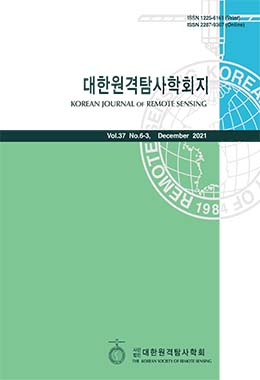최근 고해상도 광학 위성영상의 활용성이 강조되면서 이를 이용한 지표 모니터링 연구가 활발히 수행되고 있다. 그러나 고해상도 위성영상은 낮은 시간 해상도에서 획득되기 때문에 그 활용성에 한계가 있다. 이러한 한계를 보완하기 위해 서로 다른 시간 및 공간 해상도를 갖는 다중 위성영상을 융합해 높은 시공간 해상도의 합성 영상을 생성하는 시공간 자료 융합을 적용할 수 있다. 기존 연구에서는 중저해상도의 위성영상을 대상으로 시공간 융합 모델이 개발되어 왔기 때문에 고해상도 위성영상에 대한 기개발된 융합 모델의 적용성을 평가할 필요가 있다. 이를 위해 이 연구에서는 KOMPSAT-3A 영상과 Sentinel-2 영상을 대상으로 기개발된 시공간 융합 모델의 적용성을 평가하였다. 여기에는 예측을 위해 사용하는 정보가 다른 Enhanced Spatial and Temporal Adaptive Reflectance Fusion Model (ESTARFM)과 Spatial Time-series Geostatistical Deconvolution/Fusion Model (STGDFM)을 적용하였다. 연구 결과, 시간적으로 연속적인 반사율 값을 결합하는 STGDFM의 예측 성능이 ESTARFM 보다 높은 것으로 나타났다. 특히 KOMPSAT 영상의 낮은 시간 해상도로 같은 시기에서 KOMPSAT 및 Sentinel-2 영상을 동시에 획득하기 어려운 경우, STGDFM의 예측 성능 향상이 더욱 크게 나타났다. 본 실험 결과를 통해 연속적인 시간 정보를 결합해 상대적으로 높은 예측 성능을 가지는 STGDFM을 이용해 낮은 재방문 주기로 인한 고해상도 위성영상의 한계를 보완할 수 있음을 확인하였다.
As the utility of an optical satellite image with a high spatial resolution (i.e., fine-scale) has been emphasized, recently, various studies of the land surface monitoring using those have been widely carried out. However, the usefulness of fine-scale satellite images is limited because those are acquired at a low temporal resolution. To compensate for this limitation, the spatiotemporal data fusion can be applied to generate a synthetic image with a high spatio-temporal resolution by fusing multiple satellite images with different spatial and temporal resolutions. Since the spatio-temporal data fusion models have been developed for mid or low spatial resolution satellite images in the previous studies, it is necessary to evaluate the applicability of the developed models to the satellite images with a high spatial resolution. For this, this study evaluated the applicability of the developed spatio-temporal fusion models for KOMPSAT-3A and Sentinel-2 images. Here, an Enhanced Spatial and Temporal Adaptive Fusion Model (ESTARFM) and Spatial Time-series Geostatistical Deconvolution/Fusion Model (STGDFM), which use the different information for prediction, were applied. As a result of this study, it was found that the prediction performance of STGDFM, which combines temporally continuous reflectance values, was better than that of ESTARFM. Particularly, the prediction performance of STGDFM was significantly improved when it is difficult to simultaneously acquire KOMPSAT and Sentinel-2 images at a same date due to the low temporal resolution of KOMPSAT images. From the results of this study, it was confirmed that STGDFM, which has relatively better prediction performance by combining continuous temporal information, can compensate for the limitation to the low revisit time of fine-scale satellite images.




